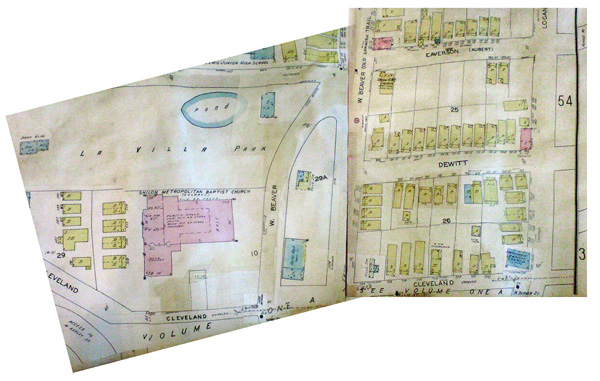These two photos were in one of the albums of Loyd Sandgren’s prints with no information and I had nothing but a hunch that they were shot at the same event. I focused my attention on trying to find information on the photograph of the procession and my detective work begin. I showed the image to a number of senior members of the Masons in Jacksonville in an effort place the location or event thinking that it was a line going into a Masonic lodge but no one recognized it as such. The presence of a couple of Shriners and the large number of folks in their Sunday best waiting in line made me think it might be something else and one gentleman suggested that it might be a funeral procession of a prominent member of the black community. He pointed out a man in the middle of the group of Masons behind the one in the white hat with a leather strap around his neck that he thought might be a preacher and the strap was part of a holder for a bible. At this point I shifted gears thinking we were at a church and the second crowd shot was likely at the same event, but which church in Jacksonville was it? I then went and visited the Durkeeville Historical Society during their monthly fish fry and showed the photos around to see if anyone there recognized the location. After a number of folks looked them over one of the members identified the interior shot as being the sanctuary of Shiloh Metropolitan Baptist Church on West Beaver Street. With that information I was able to go look around the church complex but nothing outside looked like the exterior neighborhood in the photograph. With the photograph in hand I then visited the Florida Collection at the Main Library downtown and went through the oversized platt books that show not only the streets and lots around the city dating back to the 1800’s but show individual buildings and identify them by business type. After going through a half dozen of the oversized volumes I finally found one that showed the original new Shiloh Metropolitan Baptist Church which faced West Beaver Street. On the map were two buildings across the street, one identified as Auto Repair (Crabtree’s OK Radiator) and the other as Filling Station (Dixie Vim gas station with regular gas at .28 per gallon). In the map you could see the row houses in the distant background of the photograph which were located on Eaverson Street. At the top left of the photo there is a large white structure which is labeled on the map as another church.
I went back to Shiloh and visited with Bert Brooks, the Events Coordinator of the church which started in Jacksonville’s La Villa Neighborhood in 1875 and she confirmed that the interior photo was indeed their sanctuary and although the original “new” church structure has been expanded since it’s completion in the mid 1950’s it remains the heart of the sprawling complex. I left her with copies of the photos to see if anyone at the church had any idea of the event in the photographs. After a few weeks I spoke with Ms. Brooks again and she had the final piece of the puzzle. A 95 year old member of the church identified the event as the Dedication Service for the new church building. It must have been the place to be as it was standing room only. As a side note, the other church in the photo was the previous Shiloh church building which the congregation had outgrown.
Researching these photos was quite the journey made possible only with the help of many people who guided me along the way. My sincere thanks to everyone that had a part in the process.
Tags: African-American, Beaver Street, church, group, historic photograph, La Villa, Masonic Procession, Masons, Shiloh Metropolitan Baptist Church, Shriner, vintage photography
5 Comments → Leave a Reply







How interesting! How did Loyd Sandgren come to be at Shiloh during this occasion? Have you spoken with Lydia Stewart, Curator of the Ritz Theatre and Museum? There may be an interest in having a copy of the photos for the museum.
One of the things that I find interesting about Loyd Sandgren’s body of work are the images he shot in the black community. It is not a large part of his collection but I don’t think that a white commercial photographer working in the black community was something that you would find very often during the era when he was working.
I trust that no one takes this as a “racist” comment, but as I understand, most white Masonic Orders do not recognize Black Masonic Orders. Someone correct me if I am wrong.
Outstanding detective work, Bob! Thanks again.
This photo was taken during the dedication of the new Shiloh Bpt. Church(Now the old Shiloh sanctuary)